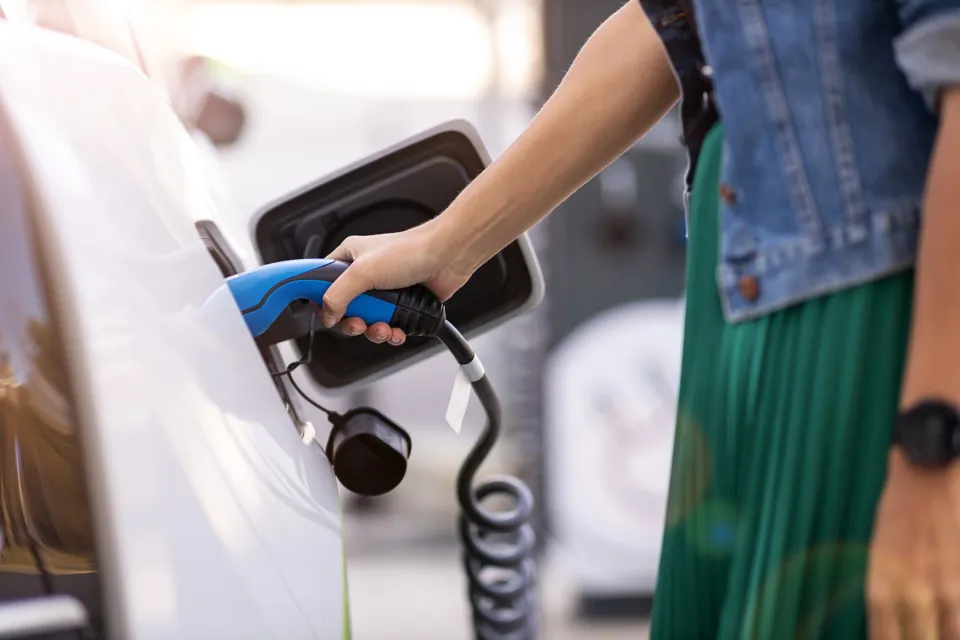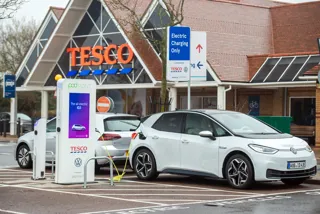Fleets have been assured that their needs will be key to the roll-out of public electric vehicle (EV) charge points, funded through a new Government scheme.
Ministers have earmarked £450 million for the Local EV Infrastructure (LEVI) scheme, with an initial nine local authorities receiving a share of £20m to install more than 1,000 public charge points in a pilot.
Nick Shaw, joint head of the Office for Zero Emission Vehicles (OZEV), said the department is working through the detail of the scheme, but fleet interests were playing “very strongly” into its final design.
“They are one of a number of key groups we’re looking at to ensure they are rightly supported with LEVI,” he added.
LEVI is specifically charged with delivering commercial EV charging infrastructure, from faster on-street charge points to larger, petrol station style charging hubs.
The industry has been highlighting inadequacies in the public charging network, particularly for vans and drivers without off-road parking, as well as in rural areas.
Research from the Association of Fleet Professionals (AFP) suggests that two-thirds (65-70%) of van drivers need kerbside charging installed.
Shaw, who was appearing on a British Vehicle Rental and Leasing Association (BVRLA) webinar, said: “If you think we're getting things wrong, do feed it in, we're looking to learn as we go through this process with LEVI. The more we can hear from people... the best it'll be for everyone.”
BVRLA’s latest Road to Zero Report Card suggests the fleet sector’s journey towards decarbonisation is being impeded by a one-size-fits-all approach to charging infrastructure.
The Report Card, which considers demand, supply and infrastructure for zero emission cars, vans and trucks, shows the general landscape for charging infrastructure is improving.
Widespread investment has bolstered the opportunities for car drivers, it says. But gaps remain for van operators, with concerns over vehicle downtime and inaccessible charge points yet to be addressed.
The ‘accessible charging specification’, which has been sponsored by the Government and the charity Motability, aims to ensure that infrastructure is accessible for all users, including disabled people.
BVRLA chief executive Gerry Keaney said: “More consideration needs to be given to the needs of all road users. Fleet operators are ready to lead the charge but are being left with one hand tied behind their backs.
“The Government is beginning to listen to these concerns, and we will continue to push the issue until authorities across the country are building infrastructure strategies that fully meet fleet needs.”
Shaw says the insights from the BVRLA report will provide "key evidence" for future policy direction, and he recognises confidence in the charging experience of drivers is crucial for widespread adoption.
The number of UK electric vehicle (EV) charge points in the UK increased by 8% from July to September – up 2,626 chargers to 34,637 public devices, figures from the Department for Transport (DfT) show.
INSTALLATION RATE
If the Government is to reach its target of 300,000 public charge points by 2030, the average rate of installations will need to increase to 2,978 each month – an uplift of 120%.
Analysis of data, by Novuna Vehicle Solutions, reveals that the number of EVs chasing every public charge point has grown threefold in just three years, rising from a ratio of 5:1 in January 2021 to a ratio of 15:1 in January 2022.
Its Electric Vehicle Ecosystem (EVE) report, which includes insights from more than 2,000 drivers, suggests this national average also masks some significant regional disparities, with drivers in the south-west (32:1) and north-west (28:1) having the hardest time finding a charger, unlike Londoners who benefit from comparatively good provision (5:1).
Furthermore, the rapidly growing competition for public charge points means that one-in-three (31%) EV drivers now frequently have to queue for a charger.
However, Shaw insisted that the Government, which has earmarked £1.6 billion to support the improvement of charging infrastructure, was “well on the way” towards its 2030 target.
He also said it will be regulating to give greater accessibility to charge point data in the coming months.
“It will help consumers locate the right charge point for their needs, tell them whether it's working and tell them whether it's available,” he explained.
“To help vans, the next phase of our work will be looking at the size of the bays, the height and parking restrictions,” he said.
With around 27,000 vehicles, BT Openreach operates one of the UK’s largest fleets and has committed to be fully electric by 2030. Andrew Kirby, strategy and business planning manager at Openreach, said fleet involvement in the location and size of charge point bays is vital.
He also believed the ability to pre-book charge points could help with downtime associated with charging, “minimising” the impact on productivity.
“Fleets present an opportunity to charge point operators and local authorities,” he said. “We can guarantee a certain level of utilisation, because we will be using our vehicles on a daily basis, and therefore need to charge on a regular basis as well.”
COST OF ELECTRICITY
Kirby, who was involved in a panel discussion on the BVRLA webinar, says another challenge facing fleets making the switch to EVs was the cost of electricity, which has adversely impacted total cost of ownership (TCO) calculations and could potentially slow fleet EV adoption.
“One of the biggest drivers for electric vehicles was with the fuelling costs of EV versus diesel,” he said. “With the rising cost of electricity, that's now on a par with diesel and, in some cases, actually more expensive than diesel.”
The spiralling cost of wholesale electricity forced Osprey Charging to recently increase its rapid charging rate to £1/kWh.
The 50% hike, from its previous rate of 66p/kWh, made it the most expensive major charge point operator (CPO), surpassing the 69p/ kWh charged by Ionity.
Osprey has now reduced its rate to 79/kWh, following the Government’s energy price guarantee.
Appearing alongside Kirby, Kim Harrison, senior category lead for fleet at the Crown Commercial Service, also reported that the cost of energy is having a “detrimental effect” on wholelife costs.
“The business case for many fleet operators to make the switch to certain types of vehicles is becoming increasingly difficult,” she said.























Login to comment
Comments
No comments have been made yet.